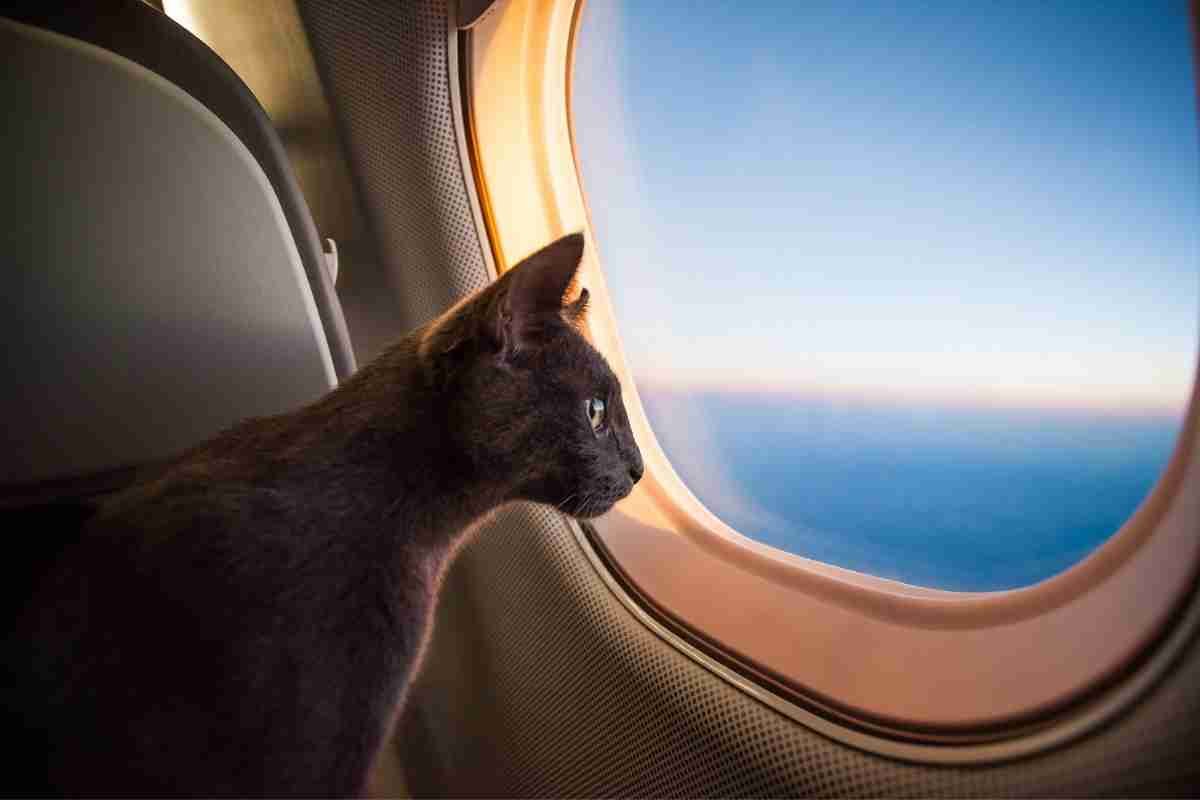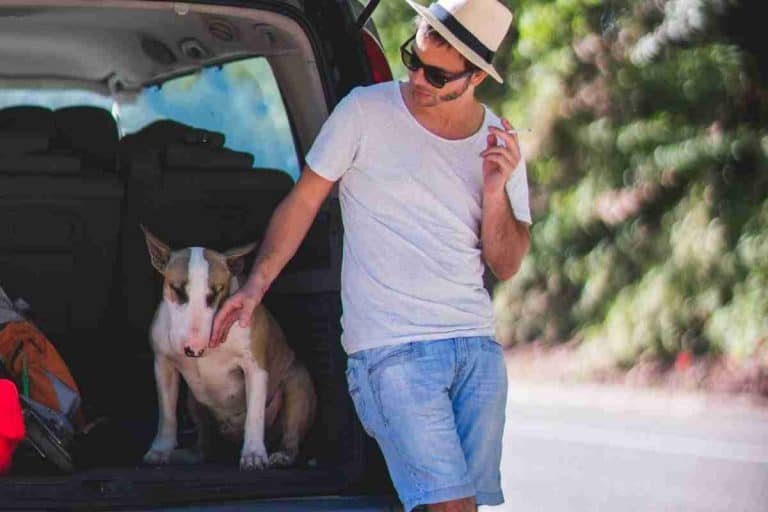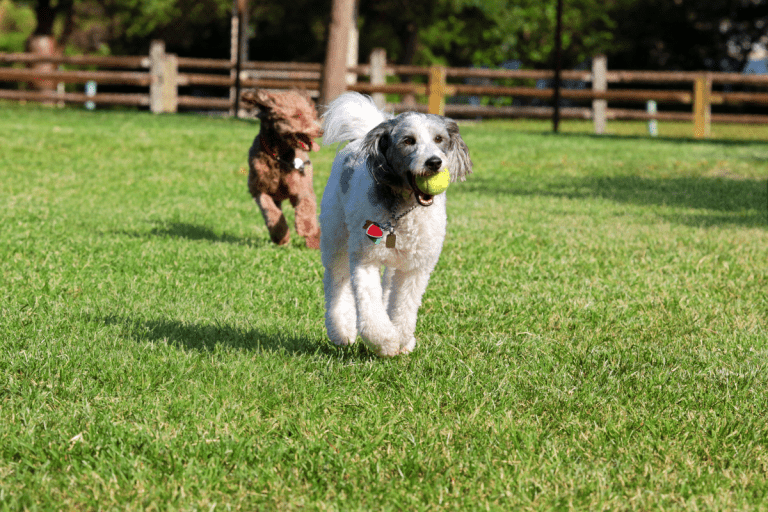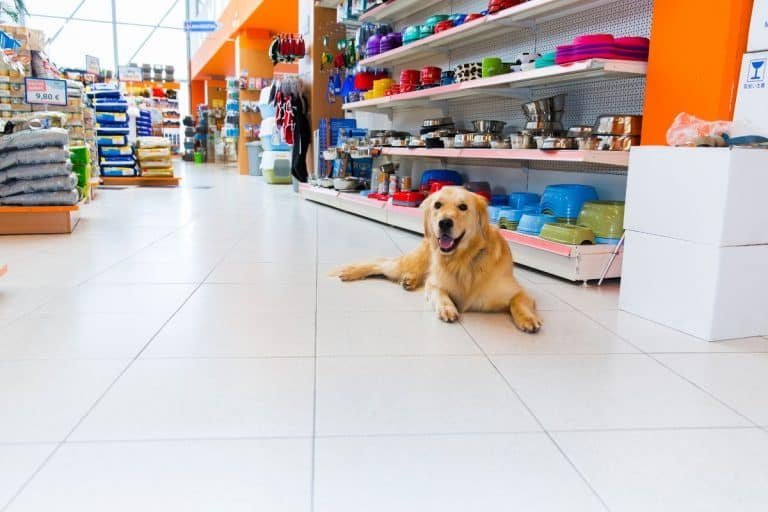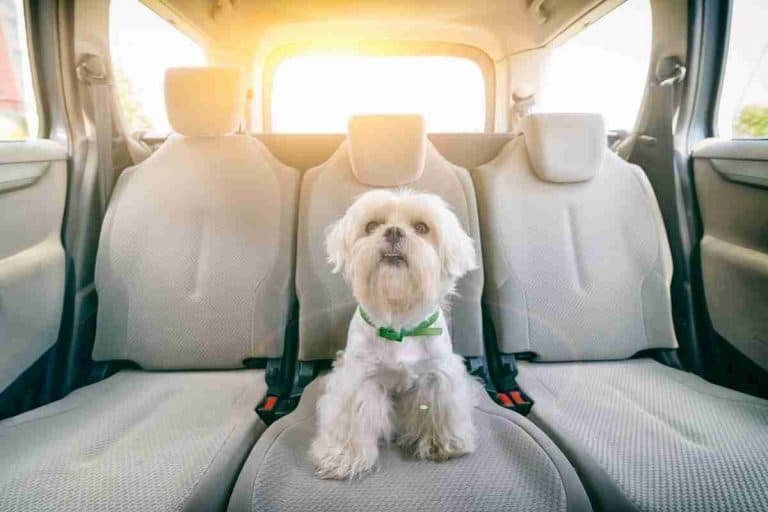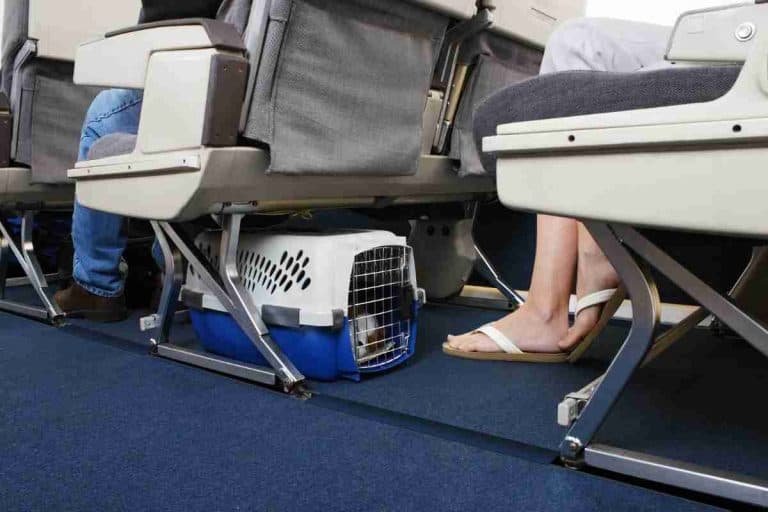How Do Cats Go to the Bathroom on a Plane? Practical Tips for Cabin, Cargo & Long Flights
Last Updated on October 11, 2025
How Do Cats Go to the Bathroom on a Plane? Most cats either hold waste for several hours or eliminate inside the carrier. In-cabin rules keep cats under the seat with no aisle or lavatory walks. Cargo and manifest cargo remove mid-flight access entirely. That makes absorbent pads, a compact travel litter tray, and smart hydration timing essential.
This guide focuses on practical tips for cabin, cargo, and long flights. Owners get a bathroom kit checklist, portable litter setups, a crew-approved lavatory method, IATA-compliant crate prep, and timing for food and water. It also highlights layover relief options and medical red flags like FLUTD. The goal: prevent messes, reduce stress, and protect urinary health at cruising altitude.
Quick answer — how bathroom needs are usually handled in flight
Cats usually either hold urine and feces for the flight or eliminate inside their carrier. Short flights commonly see cats hold for several hours. Long flights increase the chance a cat will need to go, especially if stressed or dehydrated. Airlines rarely allow cats out of carriers during flight, so owners must plan for containment and comfort.
Typical cat behavior during air travel (holding vs needing to go)
Most cats suppress elimination when stressed or in unfamiliar spaces. Many will hold for four to eight hours, though this varies. Some cats soil their carrier if frightened, motion-sick, or if a carrier becomes soiled and the cat cannot escape it. Owners should line carriers with absorbent pads and a small familiar-smelling towel to reduce accidents.
Short flights vs long-haul expectations
On short flights under four hours, expect holding as the norm. For long-haul or multi-leg travel, plan as if a bathroom event will occur. Feed small meals several hours preflight and offer water until boarding. Prefer direct routes to reduce layovers. For extended travel, discuss onboard options and alternatives with the airline before booking.
Which cats are at higher risk (kittens, seniors, urinary conditions)
Kittens under six months, seniors, and cats with urinary or kidney disease face greater risk of needing to eliminate or developing complications midflight. Cats with a history of feline lower urinary tract disease (FLUTD), diabetes, or incontinence deserve special attention. Consult a veterinarian for preflight hydration strategies and medical clearance when needed.
For behavior-focused preparation, see how to travel with a fussy feline. Owners should also check airline pet rules and consult their vet before travel.
How travel setup changes bathroom options
Air travel setup determines what bathroom options a cat has. Cabin travel confines the cat to an under-seat carrier for the whole flight. Cargo or checked travel places the cat in a hard crate that stays out of the passenger cabin. Manifest or pet-shipping services operate through cargo facilities and may allow ground breaks on long layovers.
For cabin trips, owners can prepare absorbent liners, a small travel litter tray for very short flights, and a calm preboarding routine. Cargo crates need heavy-duty absorbent bedding and proper ventilation. Manifest cargo sometimes offers scheduled ground handling, but breaks depend on the airline, airport staffing, and local regulations.
Practical rule: assume no mid-flight access unless the ticket explicitly permits ground handling. Check carrier-specific rules and size limits before booking. For lists of airlines that accept cats in the cabin, consult resources like airlines that allow cats in cabin. Pack a “bathroom kit” with pads, disposable bags, and a small scoop.
In-cabin travel — what you can and can’t do with a carrier
When a cat travels in-cabin, it must stay in its carrier under the seat for taxi, takeoff, and landing. Owners cannot remove the cat and walk it to a lavatory or aisle during flight. Airlines enforce this for safety and space reasons.
Within those limits, owners can line the carrier with absorbent pads or a thin travel litter mat. Use non-clumping, low-dust litter in a tiny, spill-resistant tray only if space allows and the carrier design secures the tray. Feed lightly and stop food four to six hours before departure to reduce accidents. Offer water up to boarding, then limit intake shortly before takeoff.
Comfort measures reduce elimination chances: a brief exercise session before security and a calm carrier familiarized at home help. For size guidance and under-seat constraints, see articles on dog breeds that fit under airplane seat, which explain how carriers must conform to airline dimensions. Pack extra pads and a portable odor eliminator. CTA: verify the carrier dimensions with the airline the week before travel.
Cargo or checked travel — crate realities and no mid-flight access
Cargo travel removes any mid-flight access to the cat. Once checked, the crate stays in the belly hold until arrival. Owners should plan for the cat to remain inside for the entire journey, plus delays.
Choose a crate that meets airline and IATA standards. The cat must be able to stand, turn, and lie down comfortably. Line the floor with multiple thick absorbent pads secured to prevent slipping. Include a small water bottle or bowl that attaches to the crate bars; top-up options depend on ground staff during transfers.
Expect soiling in long flights. Sedation raises risks due to pressure and temperature changes and usually remains discouraged by veterinarians. Coordinate arrival time to pick up the animal quickly and check crate condition immediately. For regulations and airline cargo specifics, review resources such as airlines that allow dogs in the cargo. If cargo feels too risky, consider alternate transport methods or manifest services with documented handling procedures.
Pet shipping/manifest cargo and layover break possibilities
Manifest cargo and pet-shipping services operate differently from checked baggage. Airlines list animals on a cargo manifest, and trained cargo handlers process them through specialized facilities. That setup can allow ground breaks during long layovers, but only when handlers, customs, and airport rules permit.
To create layover break opportunities, book through a reputable pet shipper or request explicit ground handling in advance. Provide clear contact info and medical paperwork so agents can authorize a brief check or comfort break. Understand that not all airports permit hands-on breaks, and weather or staffing can cancel plans.
Some airlines impose extra restrictions for brachycephalic or otherwise at-risk breeds. Review policies like those on airlines that allow snub-nosed dogs to learn how specific rules affect handling and layover options. CTA: contact the cargo agent 48 hours before departure to confirm any planned ground handling and break windows.
How long can a cat realistically hold urine and why it matters
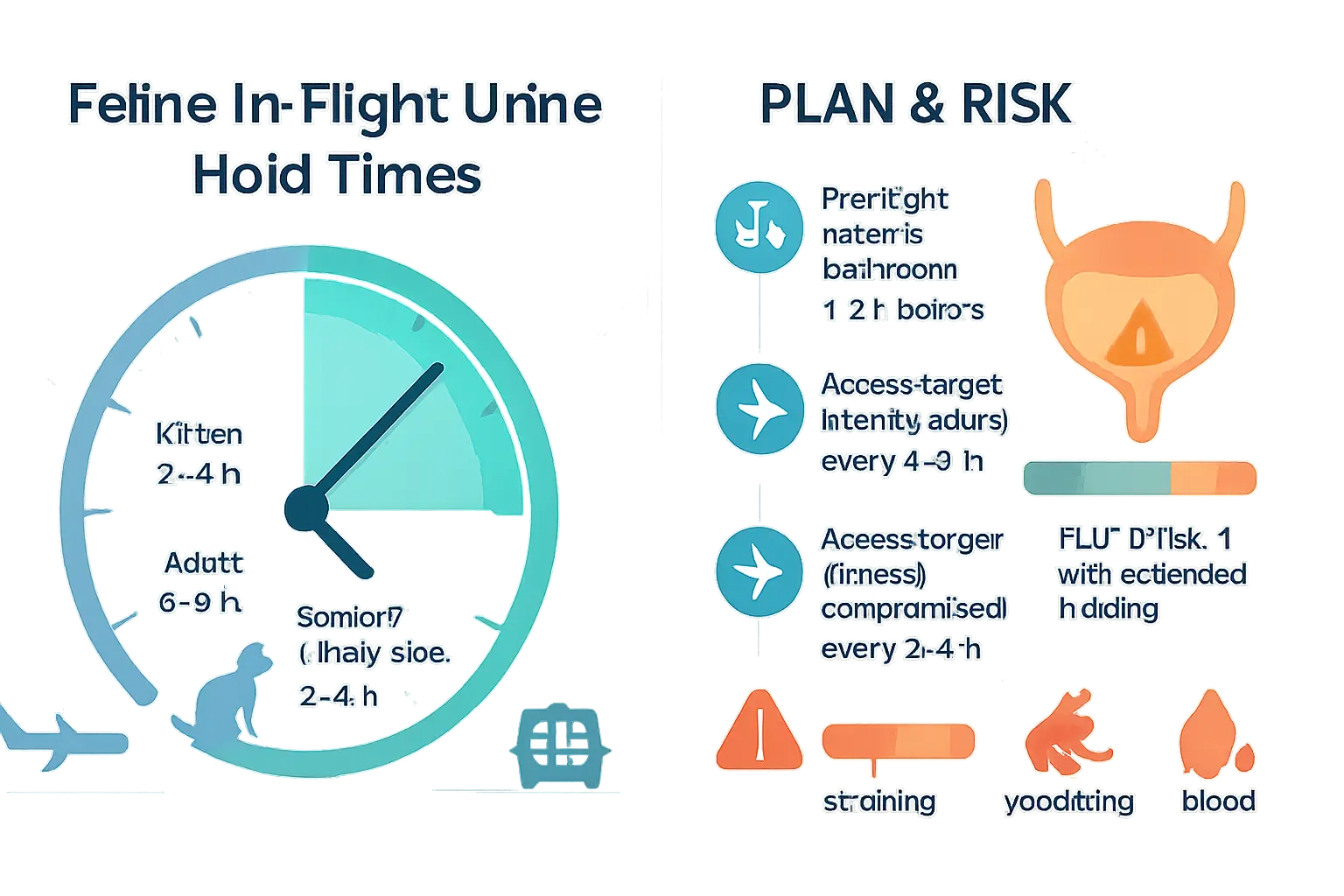
Cats can hold urine longer than many small dogs, but duration varies by age, health and circumstances. Understanding realistic limits matters for flight planning. Extended holding raises discomfort and medical risk. Owners who plan for cabin or cargo travel reduce stress and the chance of urinary problems by matching schedules and carrier setup to a cat’s needs.
Key factors: age, health, hydration and stress
Young kittens typically need a litter break every 2–4 hours. Mature adult cats often manage 6–8 hours when healthy. Senior cats and animals with kidney disease or urinary tract issues can need relief much sooner. Hydration level and ambient temperature also affect frequency. Stress from loud terminals or confinement increases urine production for some cats. For practical tips on calming and managing sensitive travelers, see how to travel with a fussy feline.
Medical risks from extended holding (FLUTD, blockages) and red flags
Extended urine retention can contribute to FLUTD (feline lower urinary tract disease), bladder inflammation, and crystal formation. Male cats risk obstructive blockages that require immediate care. Watch for signs such as repeated litter posture with little output, straining, vocalizing, lethargy, or vomiting. Any blood in urine or inability to urinate constitutes an emergency. Prompt veterinary attention prevents complications that travel delays can worsen.
Practical time guidelines for planning bathroom opportunities
Plan conservatively. Allow a pre-flight bathroom and water one to two hours before departure. For cabin trips, schedule layovers or gate time so cats have access to a carrier lined with absorbent pads every 4–6 hours for healthy adults. Kittens and compromised cats need breaks every 2–4 hours. Avoid deliberately restricting water beyond a short pre-flight window for long journeys. Consult a veterinarian for medication or specific limits, and arrange contingency plans at destination airports.
Pre-flight steps to reduce accidents and urinary risk
Travel planning reduces the chance of in-flight accidents and urinary problems. Start by choosing whether the cat will fly in-cabin or in cargo; cabin travel greatly lowers stress and exposure. Confirm airline size rules and under-seat carrier dimensions well before booking. Reserve a direct flight if possible to cut total travel time and handling. Book a bulkhead or window seat when permitted to allow easier carrier placement and access.
Prepare an emergency toileting kit: disposable absorbent pads, a small travel litter tray, plastic bags, and unscented wipes. Place absorbent padding in the carrier floor and a breathable, familiar blanket. Practice placing and removing the cat from the carrier quickly, so handling at security goes smoothly.
Check applicable airline requirements and restrictions before travel; policies vary and may affect whether the cat can ride in-cabin. See airlines that allow cats in cabin for guidance on common airline rules. Confirm all paperwork and carrier rules at least two weeks before departure, and arrive early at the airport to avoid rushed procedures.
Vet checks, vaccination/health certificates and when to seek advice
Schedule a pre-flight veterinary exam four to ten days before travel. The vet will confirm vaccinations, update records, and issue a health certificate if necessary. International and some domestic carriers require certificates within a specific timeframe; check deadlines and legalization rules early.
Discuss urinary health and existing conditions. Cats with urinary tract disease, kidney problems, diabetes, or incontinence need individualized plans. A vet can recommend whether travel is safe or if treatment must begin before departure.
Ask the veterinarian about microchip registration and accurate ID details. If the cat shows extreme stress, excessive vocalization, or recent behavioral changes, seek veterinary advice before booking. Airlines and cargo handlers will often require documentation of fitness to fly for older, pregnant, or medically compromised animals. Confirm requirements related to cargo travel as well, since policies differ between cabin and hold. For more on carrier and cargo rules, review airlines that allow dogs in the cargo.
CTA: Book the vet appointment early to allow time for tests, certificates, and any needed treatment.
Feeding, watering and timing to limit mid-flight needs
Adjust the cat’s feeding and water schedule to reduce bathroom needs during flight without dehydrating the animal. Offer a light meal four to six hours before departure. Skip heavy meals within two hours of leaving for the airport to lessen motion-related nausea and in-cabin accidents.
Provide water up until the trip to the airport, then limit free drinking once security screening begins. For long flights, provide small amounts of water during boarding or layovers. Use a spill-proof bowl or a water bottle with a shallow dish for brief sips. Avoid introducing new foods or treats on travel day.
For multi-leg journeys and long holds, plan scheduled hydration and toileting breaks during layovers. Place absorbent pads in the carrier to catch any accidents and include a small, familiar-smelling towel to encourage the cat to use a portable litter tray if necessary. For travelers seeking practical tips on managing picky eaters and hydration while traveling, see how to travel with a fussy feline.
Carrier familiarization, calming strategies and safe anti-anxiety options
Familiarity with the carrier reduces stress and urinary accidents. Leave the carrier out at home for several weeks before travel. Add the cat’s bedding and a worn t-shirt with the owner’s scent. Encourage short, frequent carrier sessions and reward calm behavior with treats or quiet praise.
Use environmental tools proven to ease feline anxiety. Synthetic feline pheromone sprays or wipes applied to carrier bedding can lower stress. Covering the carrier with a breathable towel helps some cats feel secure. Short, trial car rides in the carrier can also build tolerance to confined travel.
Mild, vet-prescribed medications sometimes help highly anxious cats. Discuss approved options with a veterinarian and ask about side effects, dosages, and airline policies regarding sedatives. Avoid over-the-counter sedatives without veterinary guidance. For behavioral calming techniques and transport-focused tips, consult how to calm down a cat in the car.
CTA: Consult the veterinarian about anxiety plans and never medicate without professional approval.
In-cabin toilet solutions and a step‑by‑step method for lavatory breaks
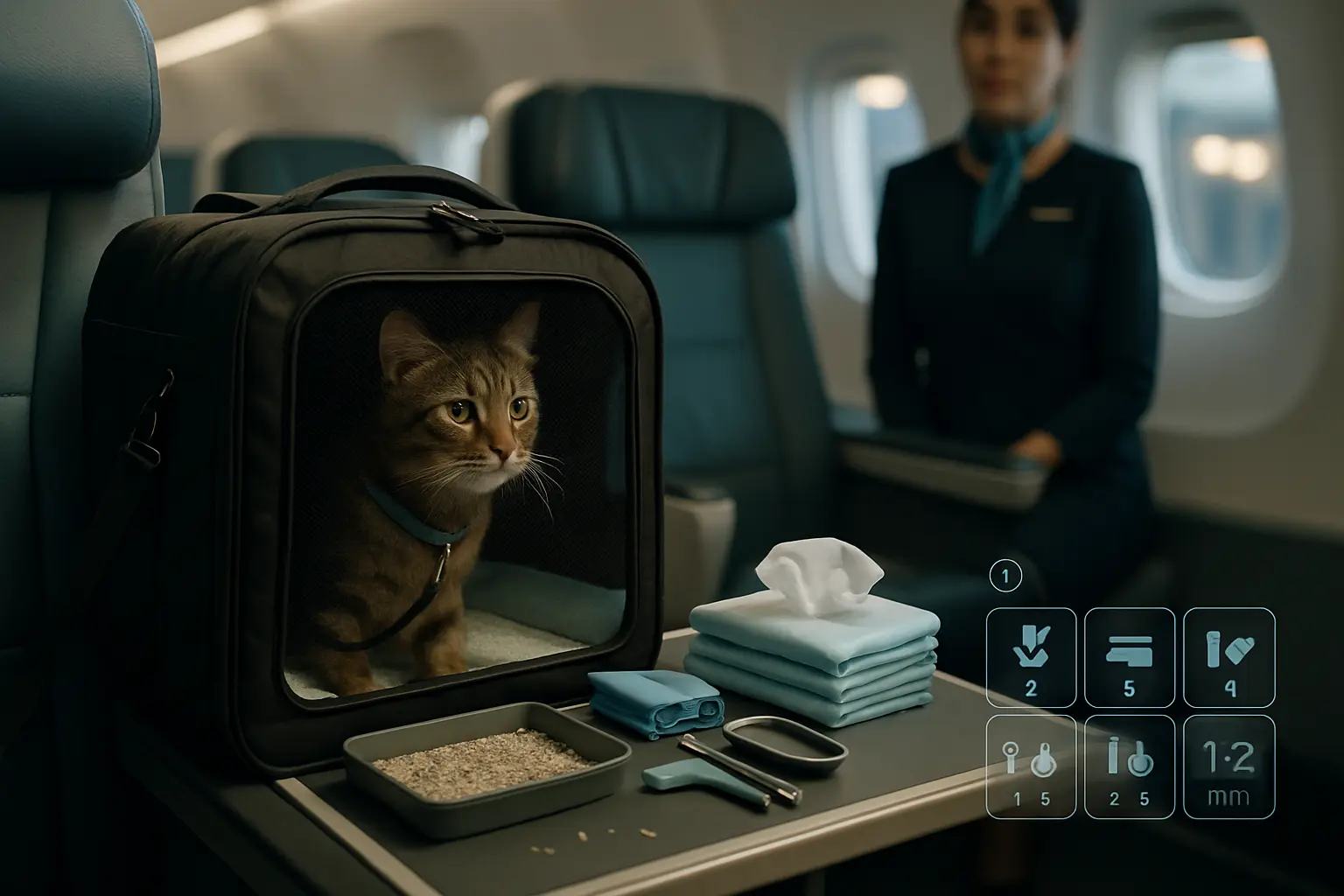
Many airlines require a cat to stay inside its carrier and remain under the seat during flight. For short flights, that usually prevents full elimination issues. For longer flights, prepare layered solutions that combine absorbent materials with containment and odor control.
Pack a compact toileting kit: a small disposable litter box or rigid travel tray, several absorbent pads, odor-control bags, unscented pet-safe wipes, and a change of bedding. Place a folded pad or thin litter tray inside the carrier’s bottom before boarding. For cats that use the carrier reliably, a shallow disposable tray with non-clumping, travel-safe litter reduces mess.
Time departing and arrival bathroom opportunities. Offer a chance to eliminate at the terminal just before boarding and again immediately after deplaning. If planning any lavatory movement, check airline policy and alert cabin crew first. Flight staff often have final authority over in-cabin pet handling and can advise on discreet timing.
How to travel with a fussy feline explains carrier conditioning and preflight practice that minimize in-cabin toileting problems.
Portable litter options: pads, disposable boxes, shredded paper alternatives
Choose portable litter with safety and cleanup in mind. The best travel options are lightweight, low-dust, and non-clumping.
- Puppy pads or absorbent liners: Thin, highly absorbent, and disposable. Fold to fit carrier and change quickly.
- Disposable cardboard litter boxes: Sturdy enough to hold litter and urine. Collapse after use and seal for disposal.
- Non-clumping crystal or silica: Low odor and low weight. Avoid clumping litters that cake and stain carrier fabric.
- Shredded paper or fleece: Soft, low-dust alternatives for cats that dislike typical litter.
Secure any tray with medical tape or Velcro to prevent sliding. Add a small amount of familiar substrate from home to encourage use. For long flights, layer a pad under a shallow tray to catch leaks.
For road and alternative travel setups, see tips at traveling with cats in an RV, which covers compact litter systems that adapt well to planes.
How to take a cat into the airplane lavatory safely and discreetly
Most carriers and airlines expect cats to remain in their carrier under the seat; removing a cat in flight often violates policy. Always ask the gate agent and a flight attendant before attempting any lavatory use.
If a flight crew member permits brief lavatory access, follow these steps. First, secure the carrier and choose a quiet moment, ideally when the aisle is clear. Carry the cat in a harness and leash rather than loose in arms. Keep movements calm to avoid startling other passengers.
Once in the lavatory, keep the door clearly engaged and limit time to a minute or two. Use a disposable pad inside a shallow travel tray if absolute relief is needed. Never leave the cat unattended. After returning, secure the carrier and discreetly clean any visible spills with the supplies from the toileting kit.
Be respectful to the crew and fellow travelers. If staff decline, accept their decision and use pre- and postflight opportunities instead. For policies and airline options that allow cabin cats, consult airlines that allow cats in cabin.
Dealing with accidents mid-flight: safe cleanup and hygiene etiquette
Accidents happen. A calm, efficient cleanup minimizes stress and disruption. First, contain the mess: place a fresh pad or tray under the soiled area to stop spreading.
Follow a cleanup checklist:
- Alert a flight attendant for assistance and waste disposal options.
- Use disposable gloves and pet-safe wipes to remove solids and urine.
- Double-bag all soiled pads, bedding, and litter in plastic bags. Seal tightly.
- Spritz air or fabric with a pet-safe odor neutralizer if available. Avoid strong human perfumes near the cat.
- Replace the carrier lining with a clean pad and dry any damp spots as best as possible.
Practice good hygiene: dispose waste per crew instructions, then sanitize hands. Offer a brief apology to nearby passengers if the odor or sight affected them. Restock the toileting kit after the flight.
For related vehicle-accident cleanup techniques, see practical guidance at dog poops in car. Pack a compact emergency kit and check airline rules before travel to reduce surprises.
Preparing crates and planning for cargo or long multi-leg trips
Select a crate that meets airline size and construction rules and that gives the cat space to stand, turn and lie down comfortably. Measure the cat while stretched and compare to carrier interior dimensions. For in-cabin travel, verify the carrier fits under the specific aircraft seat; for checked cargo, use a rigid, airline-approved crate with secure latches and ventilation on three sides. Book flights with the fewest connections and the shortest total travel time to reduce stress. When multi-leg travel is unavoidable, map layovers and plan buffer time for delays, inspections and pet-relief opportunities.
Prepare paperwork early: health certificates, vaccination records and any required permits. Label the crate with contact info, flight details and “Live Animal” stickers. Acclimate the cat to the crate weeks before travel by making it a safe, familiar space with bedding and short practice sessions. For advice on securing carriers in vehicles and transfer procedures, consult practical guides like how to secure a cat carrier in car. Confirm all airline and international rules before purchase and check-in.
Crate lining, secure water systems and absorbent materials
Line the crate floor with a non-slip waterproof layer topped by highly absorbent pads. Use several disposable or washable absorbent pads so staff can replace them during long stops. Avoid loose litter; it scatters and irritates air filters. Instead, choose low-dust, clumping-free pads designed for travel. Place familiar-smelling bedding on top to calm the cat and to encourage lying on the pad.
For hydration, install a spill-proof water bottle or a travel bowl that clips to the crate wall. Secure bowls with Velcro or crate-mounted holders to minimize tipping during handling. Consider freezing a small portion of the water to reduce sloshing while still offering liquid as it melts. Pack extra water, syringes for controlled offering, and antiseptic wipes for quick cleanups. Keep a sealed bag of spare pads, disposable gloves and plastic bags accessible to handlers. For crate and product recommendations that perform well under travel conditions, review comprehensive crate guides like best dog crates for car travel in 2023 — a comprehensive review.
Scheduling connections, using airport pet-relief areas during layovers
When booking, prioritize flights that allow at least one hour between gates for domestic connections and two hours for international transfers. Those buffers permit security re-checks and short relief breaks. Research airports’ pet-relief areas along the planned route; official airport websites list locations, hours and whether relief areas sit post-security. Some airports offer indoor, turf-lined relief stations; others have outdoor options only.
Feed lightly and limit water two to four hours before departure to reduce accidents, then offer small amounts during long layovers. Use the layover to let the cat stretch on a leash in a designated relief area, if the cat tolerates handling. If a layover will last several hours, arrange a quiet, secure space where a handler can check the animal periodically. For tips about in-cabin allowances and how relief areas factor into route choice, see airline policy resources such as airlines that allow cats in cabin.
Working with airlines, cargo handlers and pet relocation services
Contact the airline’s pet desk before booking to confirm carrier dimensions, fees and temperature or breed restrictions. Ask about cargo hold climate control, minimum and maximum check-in times, and whether the airline certifies third-party handlers. When shipping via cargo, require a climate-controlled service and written confirmation of the travel chain, especially for summer or winter months.
For complex international moves, hire a certified pet relocation company that manages paperwork, customs clearance and ground transport. Verify credentials, request references and confirm the company follows IATA Live Animal Regulations. Label crates with full itinerary and emergency contacts. At check-in, remain until the agent confirms the animal’s placement and obtains a receipt. Call the airline’s pet desk within 48 hours of departure to re-confirm arrangements. For guidance on airline cargo policies and handling, consult resources like airlines that allow dogs in the cargo.
Rules, packing essentials and emergency signs to watch for
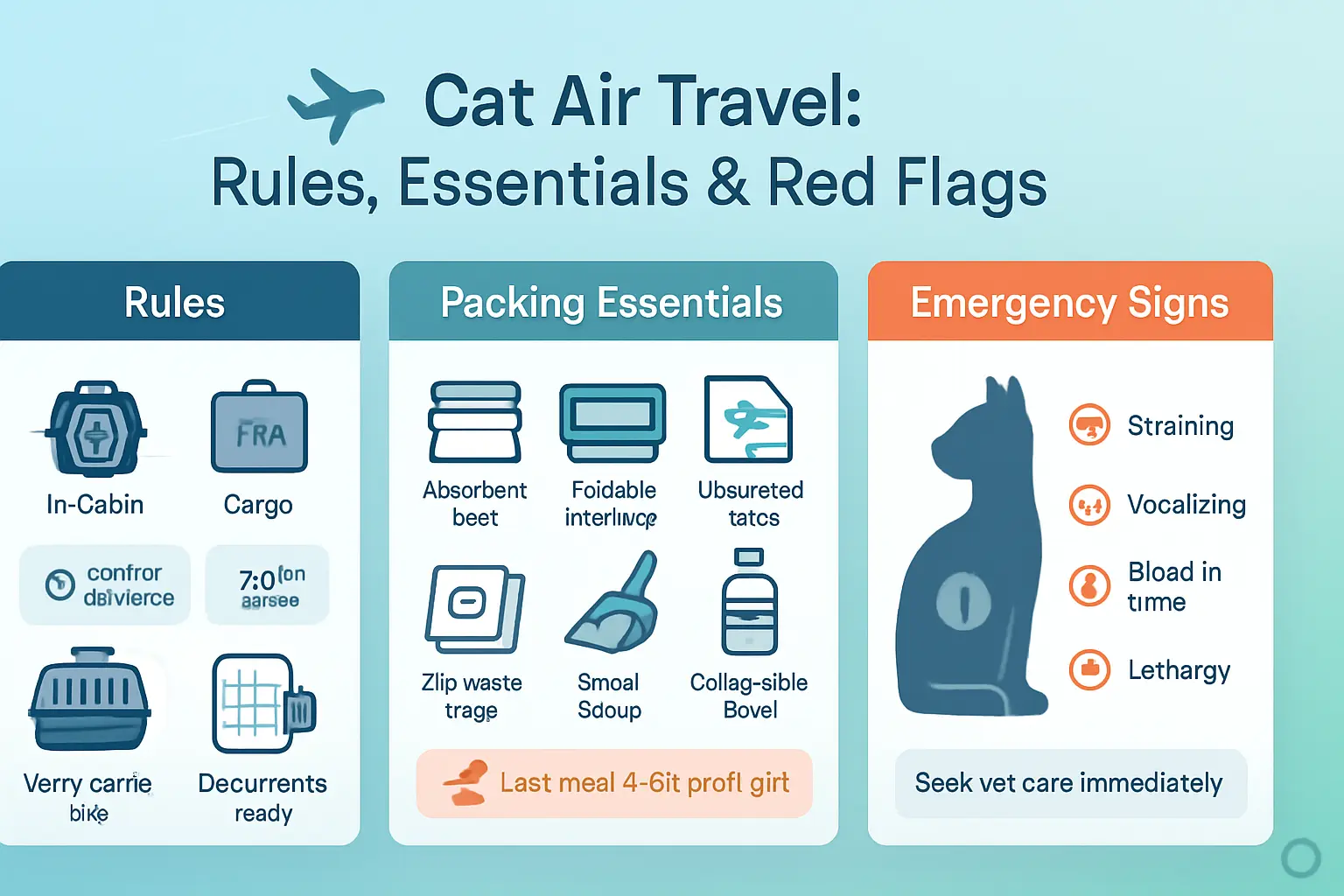
How Do Cats Go to the Bathroom on a Plane? Practical Tips for Cabin, Cargo & Long Flights begins with clear rules and a streamlined packing list. Airlines treat in-cabin and cargo travel differently. Cabin trips allow short breaks at the gate and under-seat carriers. Cargo flights place animals in pressurized, temperature-controlled holds but add handling stress and no access during flight. Owners should verify carrier dimensions, weight limits and fee policies well before travel. For a quick start on which carriers accept pets, see airlines that allow cats in cabin.
Packing essentials include absorbent pads, a compact litter tray, disposable scoops, unscented wipes, a small water bottle and a familiar-smelling cloth. Store these items in a clear, easily reachable bag to speed security checks. Keep copies of vaccination records and a vet health certificate near the carrier. Finally, watch for early signs of urinary distress, such as repeated straining or dark urine. Note these signs and prepare to act quickly; the next sections outline airline/TSA basics, a carry-on checklist and urgent actions to take.
Airline and TSA basics: carrier sizes, fees, what you can bring onboard
Each airline sets specific carrier size and weight limits and enforces them at the gate. Soft-sided carriers often work best under seats because they compress slightly. Hard crates meet cargo rules better but rarely fit under seats. Service animal rules differ from pet policies; documentation requirements vary. Familiarize the carrier’s external dimensions and test that the cat can stand, turn and lie down comfortably.
TSA allows pet carriers through security. Agents may ask to remove the cat briefly; keep a harness and leash ready. Medications qualify as carry-ons; label them and carry a vet note for controlled drugs. Liquid limits do not apply to medications, but agents may inspect them. Fees often apply per segment, and peak-season surcharges occur. Call the airline to confirm fees and acceptability at least 72 hours before departure to avoid surprises. For how airlines handle animals in different areas, check policies like those in airlines that allow large dogs in cabin, which provide useful policy comparisons.
Carry-on packing checklist (litter, pads, wipes, scoops, water, scent items)
Pack to manage toilet needs during gate holds, long layovers and unexpected delays. Essentials include:
- One or two disposable absorbent pads sized to the carrier floor.
- A compact, foldable litter tray that snaps into place.
- A small bag of non-clumping litter or disposable liners.
- Unscented wipes and paper towels for quick cleanups.
- A collapsible water bowl and a 12–16 oz water bottle.
- A scoop, zip bags for waste, and a sealed trash bag.
- A small cloth or blanket carrying a home scent to calm the cat.
Store everything in an organized toiletry-style pouch so staff can access items fast. Replace pads immediately after use to prevent odors and infection. If a cat resists the carrier, use proven calming strategies from resources like how to secure a cat carrier in car, which help with carrier familiarity and restraint tips. Pack one extra pad and rinseable bowl for long flights or delays.
Urgent signs of urinary distress and immediate actions to take
Recognize urinary distress early. Key signs include persistent straining, vocalizing while trying to urinate, repeatedly assuming a litter posture without producing urine, and lethargy. Dark, bloody or strong-smelling urine also indicates trouble. These signs can mean a urinary blockage, especially in male cats, which becomes life-threatening within hours.
If signs appear before boarding, cancel or delay travel and seek emergency veterinary care. At the airport, move the cat to a calm, quiet area and offer water. Do not attempt to treat a suspected blockage in transit. If symptoms start mid-journey, notify cabin crew immediately. They can often provide a quieter space and contact ground staff to arrange urgent care on arrival. For handling anxious cats and preventing escalation, consult tips from how to travel with a fussy feline. A clear CTA: if a cat shows urinary distress at any point, get veterinary help before continuing travel.
Quick FAQs and final preparedness checklist
Short answers to common concerns (sedation, 10+ hour flights, litter on plane)
Cats tolerate air travel differently than dogs. Owners should evaluate risk, not assume sedation or long stints in cargo are safe. Veterinarians may recommend light anti-anxiety measures, but many airlines and vets advise against routine sedation. Sedatives can depress breathing and thermoregulation, especially for brachycephalic breeds and older cats. Airlines also set rules; always confirm with the carrier before dosing.
For flights longer than ten hours, the safest option is to keep the cat in-cabin when possible. Cargo travel increases stress and adds temperature and handling risks on long hauls. Book a direct flight, choose non-peak travel times, and select an airline known for pet care. Consult lists of pet-friendly carriers to compare policies and cabin allowances.
Bringing litter on board works if done carefully. Use a shallow, spill-proof travel tray lined with an absorbent pad and minimal litter to reduce odor and mess. Replace pads between flights. Secure the tray inside a carrier so it cannot shift. Carry enzyme wipes, sealable disposal bags, and small scoops to clean up quickly. For extra guidance on calming techniques and handling picky travelers, see how to travel with a fussy feline.
One-page pre-flight checklist to print or save
Documents and confirmations
- Current rabies and vaccination certificates, health certificate (per airline and destination)
- Reservation confirmation that lists the cat and carrier—keep screenshots and printed copies
Carrier and containment
- Airline-approved carrier sized to allow standing, turning, and lying down
- Secure fasteners and airline ID tag; attach contact details and itinerary
- Stabilize a small, sealed litter tray or absorbent pad inside the carrier (see carrier-secure tips)
Food, water, medications
- Put the last full meal 4–6 hours before departure to reduce in-flight elimination
- Pack measured wet or dry food for the trip plus any prescribed meds and a syringe for dosing
- Collapsible water bowl; offer water before boarding and immediately after landing
Hygiene and comfort
- Absorbent travel pads, small scoop, sealable poop bags, enzyme wipes
- Familiar blanket or T-shirt and a pheromone spray applied to bedding 15 minutes before use
Day-of checklist
- Confirm direct flight and early boarding if available
- Label carrier with name, phone, and destination address
- Take a short play/walk session to tire the cat before travel
- Place pad and minimal litter in carrier; close and test stability
Emergency items
- Vet contact numbers at origin and destination
- Microchip info and recent photo of the cat
Print or save this checklist and tick items off the day before travel. For carrier fastening and in-vehicle prep tips, consult how to secure a cat carrier in car.
Summary
How Do Cats Go to the Bathroom on a Plane? Practical Tips for Cabin, Cargo & Long Flights explains that most cats either hold their urine and feces for several hours or eliminate inside the carrier, so planning for both outcomes is essential. The post compares in-cabin, cargo, and manifest cargo travel, outlining realistic bathroom options, airline constraints, and safe, discreet methods for handling accidents or permitted lavatory breaks.
Readers learn how to reduce risks with smart pre-flight prep: timing meals and water, lining carriers with absorbent pads, using compact travel litter, and conditioning the cat to the carrier. It highlights higher-risk cats, medical red flags such as FLUTD and blockages, sedation cautions, crate setup for cargo, and how to coordinate with airlines and handlers. The conclusion: assume no mid‑flight access, prepare a bathroom kit, confirm policies in advance, and consult a veterinarian for individualized guidance.
Key Takeaways
- Assume no mid‑flight bathroom access: Line the carrier or crate with absorbent pads and pack a compact toileting kit (travel tray, minimal non‑clumping litter, wipes, disposal bags).
- Time food and water: Offer a light meal 4–6 hours pre‑departure, water until boarding, and small sips during layovers; avoid deliberate long-term dehydration.
- Match setup to the trip: In‑cabin reduces handling stress; cargo requires an IATA‑compliant crate, secured water system, and heavy-duty absorbent bedding, with no access until arrival.
- Plan conservatively for long hauls: Prefer direct flights, build layover buffers, and arrange written ground handling only through approved cargo/pet shippers.
- Protect urinary health: Kittens, seniors, and cats with FLUTD, kidney disease, or diabetes need vet clearance and shorter break intervals; watch for straining, vocalizing, or blood in urine.
- Avoid routine sedation: Use only vet-prescribed, airline‑approved anxiety options; sedation can increase respiratory and temperature risks.
FAQ
What can a cat use as a toilet during a flight? For most trips, absorbent pads inside the carrier handle accidents. On longer flights, a shallow, secure travel tray with non‑clumping litter may help, and any lavatory use requires cabin crew permission.
How long can a cat hold urine on a plane? Many healthy adults manage 4–8 hours; kittens, seniors, and cats with urinary or kidney issues often need relief sooner. Plan as if a bathroom event could occur on long or multi‑leg journeys.
How should owners prepare the carrier or crate for bathroom needs? Use layered absorbent pads over a waterproof base, add familiar bedding, and secure a spill‑resistant water source. For cargo, choose an IATA‑compliant crate and expect no mid‑flight access.
Why is sedation discouraged for flying cats? Sedatives can impair breathing and thermoregulation and may interact with pressure or temperature changes. Most airlines and veterinarians advise avoiding routine sedation unless a vet prescribes a specific, tested plan.
How do manifest cargo services handle bathroom breaks on long trips? Some routes allow scheduled ground checks during long layovers, but only with prior, written arrangements and when airport rules permit. Travelers should confirm details with the cargo agent 48 hours before departure and still assume no mid‑flight relief.

